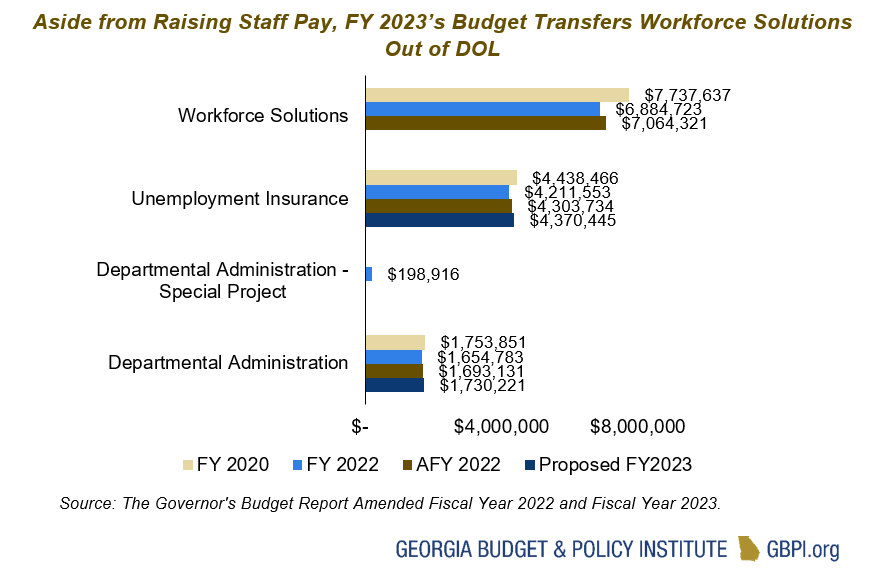The governor is requesting modest spending increases to the Department of Labor (DOL) to amend to the current fiscal year (FY 2022) while seeking major budgetary changes that would transfer select programs out of DOL’s purview in the next fiscal year (FY 2023). The request amends the current fiscal year (FY 2022) spending plan by providing a .9 percent bump in spending and decreasing funds by 52 percent in FY 2023.
The amended budget request brings the FY 2022 budget for the agency to $13.1 million, up from $12.9 million. If approved, the governor’s FY 2023 budget request would transfer out a significant share of DOL program services to the state’s Technical College System (TCSG) and therefore reduce its spending to $6.1 million in the new fiscal year. Aside from this proposed transfer of spending and select program services to TCSG, remaining DOL programs in the new fiscal year would maintain reductions to staffing capacity that were enacted following COVID-19, accounting for more than $500,000 in cuts to vacant positions across the budgets of Amended Fiscal Year 2020 and Fiscal Year 2021.

By the Numbers
Proposed Amended FY 2022 Highlights
- Over $310,000 added to provide pay increases for full-time eligible employees.
- $199,000 reduction to reflect the elimination of funds tied to failing 2021 legislation that sought the appointment of a Chief Labor Officer.
Proposed FY 2023 Highlights
- $430,000 added to provide cost-of-living adjustments (COLA) for all full-time eligible employees.
- $141,000 to cover retiree benefits and 401(k) employer match increases for all full-time eligible employees.
- Another $199,000 reduction to reflect the elimination of funds tied to failing 2021 legislation that sought the appointment of a Chief Labor Officer.
- $7.2 million reduction to reflect the full transfer of Employment Services programs to TCSG, which include:
- Workforce Innovation and Opportunity Act (WIOA) Title I programs which provide adult education and literary services that can be paired with industry-specific workforce education and training; and
- WIOA Title III programs, which provide Wagner-Peyser employment services that offer career planning and counseling, match jobseekers with suitable employers and pair jobseekers with relevant education and training programs.
Wage Protections for Involuntary Jobless Workers
The agency is tasked, as part of the state’s safety net, with delivering wage-replacing benefits known as Unemployment Insurance (UI). These benefits serve as an anti-poverty tool to protect working families from economic hardship during recession-induced periods of heavy job loss, as well as during the normal ebb and flow of non-recession job losses. More broadly, it maintains consumer spending while temporarily supporting jobless workers as they seek and prepare for new suitable employment, which supports businesses and helps to maintain consistent local and state tax revenue.
While a significant portion of DOL program administration is federally funded, state funding allocations provide dedicated funding sources to maintain the efficiency of the state’s unemployment insurance system through the ebbs and flows of federal funding.
Since the start of the COVID pandemic, the DOL has processed unprecedented amounts of claims—more than 5.1 million—and paid out billions in benefits to jobless Georgians turning to the UI safety net.[1] During some of the heaviest periods of the pandemic, and despite its critical role in stabilizing families and the larger economy, the agency cut spending by more than $500,000, eliminating eight vacant positions across its Unemployment Insurance and Departmental Administration divisions that were tasked with helping distribute unemployment benefits and supplying labor market information. While proposing pay and benefit increases for current staff, the governor’s budget request maintains the pandemic cuts to the agency’s staffing capacity, which remains below FY 2020 pre-pandemic levels.
Reemployment Services
DOL’s Workforce Solutions division has been responsible for administering various reemployment services throughout the pandemic recovery, including career counseling, providing available job market information, job search assistance, referrals to employers and occupational skills training. While the agency shifted some staff from other divisions to handle the pandemic surge of UI claim filings, it also reduced this division’s staff capacity as part of pandemic budget cuts, reducing spending by more than $840,000 to eliminate 17 vacant positions across AFY 2020 and FY 2021 and maintaining these harmful cuts to staff capacity through the current fiscal year. And while the governor’s budget request for FY 2023 seeks to streamline employment services by transferring those operations out of DOL and all into TCSG, the residual harms that contributed to a delayed recovery may be felt by some Georgians for years to come.
Broader Budget Implications
The agency’s sustained budget cuts to employment services and other agency operations have likely added another roadblock to economic recovery, particularly for Black and Hispanic Georgians of color, who have disproportionately experienced several issues across DOL entry and exit points in the pandemic:
- Black UI applicants in Georgia were more likely to be denied than white applicants.[2]
- Among Black and Hispanic jobless workers who met UI eligibility criteria, their UI enrollment levels have declined more than twice as slowly as white and Asian UI claimants since April 2020.[3]
- Fewer DOL employment services staff have likely left many unemployed and underemployed Georgians underserved, leaving them without adequate assessment of their employment barriers, case referrals or training needs. These gaps are likely felt most by Black women in Georgia, who now lead all Georgians in unemployment and underemployment and nearly double white men and women in both categories.[4]
Rather than prioritize state investments that could help advance UI modernization efforts and restore pre-pandemic staff capacity levels, which could improve UI benefit accessibility, these and related agency proposals are reminiscent of past policy choices that have slowed economic recovery, particularly for low-income Georgians that are most vulnerable to job losses during recessions and have the greatest barriers to reemployment during recovery.
Adding to those missed opportunities to prepare for future economic downturns, the agency’s request to the Governor’s Negative Economic Impact Committee for $800 million of the total $4.9 billion in ARP fiscal recovery funds diverts additional funding away from UI program investments that could benefit impacted individuals, in order to hold down business tax rates.[5]
As state lawmakers consider the merits of current DOL budget proposals along with potential uses of Georgia’s allocation of ARP federal recovery funds, they must consider how the state’s unemployment safety net will reach those who have yet to experience recovery. Additionally, lawmakers must consider how our unemployment safety net can utilize available revenue sources to equitably restore the UI Trust Fund without further restricting access to UI benefits, and how it can continue to strengthen its ability to weather future economic downturns.
Endnotes
[1] GBPI analysis of DOL weekly UI claims data.
[2] Donnan, S. Pickert, R. Campbell, M. (2021, November). “Georgia shows just how broken American unemployment benefits are.” Bloomberg. https:// www.bloomberg.com/graphics/2021-georgia-unemployment-bias/?srnd=premium&sref=2XhWEs2V
[3] GBPI analysis of DOL ETA 203 reports.
[4] GBPI analysis of Current Population Survey IPUMS microdata.
[5] Governor’s Office of Planning and Budget. Submitted ARPA Grant Applications. (2022) https://opb.georgia.gov/submitted-arpa-grant-applications









